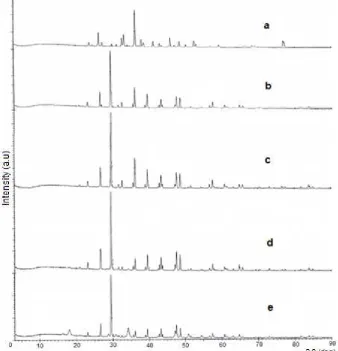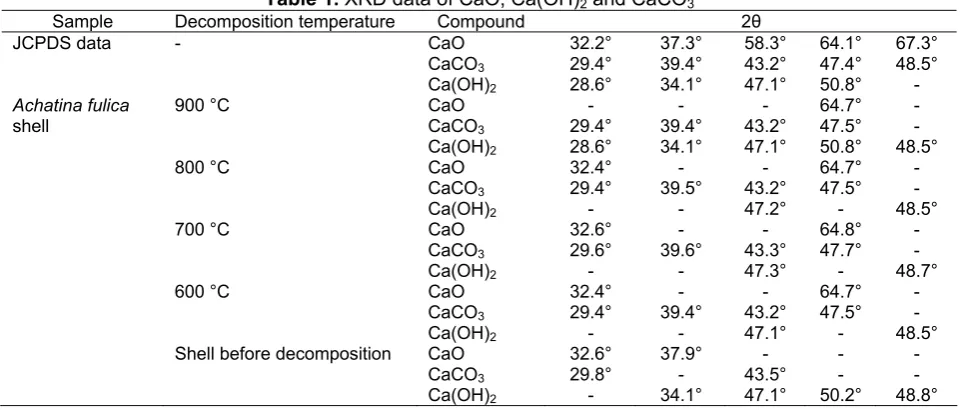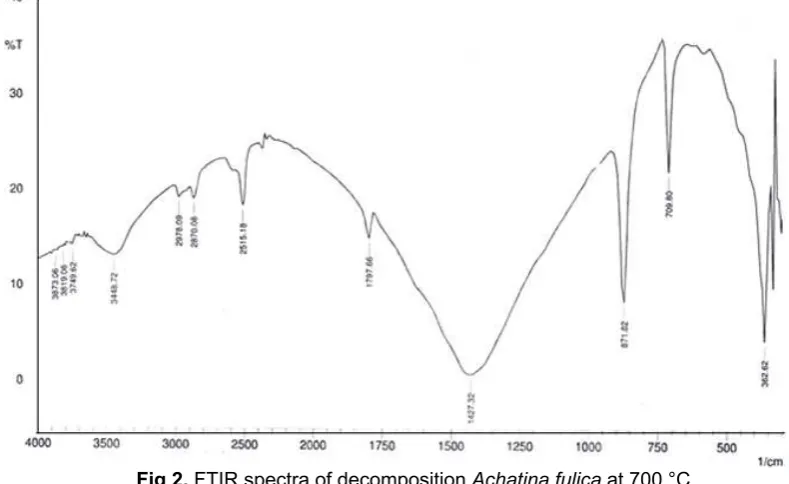Indo. J. Chem., 2013, 13 (2), 176 - 180
Aldes Lesbani et al. 176
* Corresponding author.
Email address : aldeslesbani@yahoo.com
PREPARATION OF CALCIUM OXIDE FROM
Achatina fulica
AS CATALYST
FOR PRODUCTION OF BIODIESEL FROM WASTE COOKING OIL
Aldes Lesbani*, Palita Tamba, Risfidian Mohadi, and Fahmariyanti
Department of Chemistry, Faculty of Mathematic and Natural Sciences, Sriwijaya University Jl. Raya Palembang Prabumulih Km 32 Ogan Ilir 30662 South Sumatera Indonesia
Received June 5, 2013; Accepted June 21, 2013
ABSTRACT
Preparation of calcium oxide from Achatina fulica shell has been carried out systematically by decomposition for 3 h at various temperatures i.e. 600, 700, 800 and 900 °C. Formation of calcium oxide was characterized using XR diffractometer. The calcium oxide obtained with the optimum temperature decomposition was characterized using FTIR spectroscopy to indicate the functional group in the calcium oxide. The results showed that XRD pattern of materials obtained from decomposition of Achatina fulica shell at 700 °C is similar with XRD pattern of calcium oxide standard from Joint Committee on Powder Diffraction Standards (JCPDS). The IR spectra of calcium oxide appear at wavenumber 362 cm-1 which is characteristic of CaO vibration. Application of calcium oxide from Achatina fulica shell for synthesis of biodiesel from waste cooking oil results in biodiesel with density are in the range of ASTM standard.
Keywords: calcium oxide; Achatina fulica shell; biodiesel; waste cooking oil
ABSTRAK
Telah dipreparasi kalsium oksida dari Achatina fulica secara sistematis melalui dekomposisi selama 3 jam pada temperatur 600, 700, 800, dan 900 °C. Pembentukan kalsium oksida dikarakterisasi menggunakan alat XRD. Kalsium oksida yang diperoleh dari dekomposisi pada temperatur optimum dikarakterisasi lanjut menggunakan spektroskopi FTIR untuk mengidentifikasi gugus fungsional pada kalsium oksida. Hasil penelitian menunjukkan bahwa pola XRD dari cangkang Achatina fulica yang didekomposisi pada 700 °C mirip dengan pola XRD kasium oksida standar dari Joint Committee on Powder Diffraction Standards (JCPDS). Kalsium oksida yang diperoleh dari dekomposisi pada 700 °C memiliki spektra IR yang muncul pada bilangan gelombang 362 cm-1 yaitu vibrasi khas dari CaO. Penggunaan kalsium oksida hasil preparasi untuk sintesis biodiesel dari minyak jelantah menghasilkan biodiesel dengan densitas dan viskositas yang sesuai dengan standar ASTM.
Kata Kunci: kalsium oksida; cangkang Achatina fulica; biodiesel; minyak jelantah
INTRODUCTION
Biodiesel is renewable fuel, which can be synthesized from various plant oils (edible and non edible) including waste cooking oils and animal fat oils [1-2]. The advantages of biodiesel for transportation fuel due to green emissions, non-toxic, displacement of petroleum fuel, high flash point and good lubricity. Synthesis of biodiesel through transesterification of oils with alcohol using catalyst produces fatty acid alkyl esters or biodiesel with glycerol as a byproduct [3]. Fatty acid alkyl esters and glycerol are easily separated using physical or chemical process. Alcohols with low carbon chain such methanol and ethanol is commonly used for transesterification [4].
Homogeneous and heterogeneous catalysts can be used for synthesis of biodiesel from various oils [5].
Aldes Lesbani et al.
Fig 1. The XRD pattern of decomposition Achatina fulica at various temperatures: (a) Achatina fulica shell, (b) 600 °C, (c) 700 °C, (d) 800 °C, (d) 900 °C
Yang et al. [13] used shrimp shell enriched by potassium fluoride for biodiesel production with high catalytic activity. Shrimp shell was carbonized and potassium fluoride was added by impregnation method. The shrimp shell catalyst was characterized using XRD, elemental analysis, EDS and FTIR. Wei et al. [14] reported that waste eggshell could be used heterogeneously for transesterification and reused catalyst. The main chemical composition of shrimp shell and eggshell is CaCO3 with base properties. By decomposition of shells in various temperatures can produce CaO, which has high catalytic activity for transesterification.
Achatina fulica (Indonesian; bekicot) is also containing CaCO3 in the shell with high yield (88-99%) [15]. In Indonesia, the habitat of Achatina fulica usually is in banana tree and it is consumed with special name “crispy fried bekicot”. The Achatina fulica shell is organic waste that can be applied as renewable CaO catalyst for biodiesel production. In the present work, the Achatina
fulica shell has been used as raw material of
heterogeneous catalyst for transesterification of waste cooking oil for biodiesel production. Waste cooking oil is used as cheaper feedstock, which can reduce the production cost for biodiesel production.
EXPERIMENTAL SECTION
Materials
All chemicals with analytical grade were purchased and used without further purification from Merck such as ethanol, potassium hydroxide, oxalic acid, sodium sulfate, phosphoric acid, and methanol.
Achatina fulica shell was obtained from several
Indo. J. Chem., 2013, 13 (2), 176 - 180
Aldes Lesbani et al. 178
Table 1. XRD data of CaO, Ca(OH)2 and CaCO3
Sample Decomposition temperature Compound 2θ
JCPDS data - CaO
Shell before decomposition CaO
CaCO3
The X-ray powder diffraction (XRD) pattern was collected from Shimadzu Lab. X type 6000. The data were collected over 2 range of 0-90° at a scanning speed of 1° min-1. The FTIR spectra were recorded using Shimadzu 8201PC.
Procedure
Decomposition of Achatina fulica shell to form calcium oxide
The decomposition procedure for Achatina fulica
was adopted from Nakatani et al. [16] as described as follow. 100 g of dry shell was decomposed with in electric furnace in air at given temperature (600, 700, 800, and 900 °C) for 3 h and then the combusted shell was stored in desiccators over silica gel for overnight. The white solid bulk was analyzed using XRD diffractometer. The XRD pattern of combusted shell was compared with XRD pattern of calcium oxide from Joint Committee on Powder Diffraction Standards (JCPDS). The similarity XRD combusted shell with JCPDS pattern will be used as catalyst for transesterification of waste cooking oil.
Transesterification of waste cooking oil using calcium oxide as catalyst
Transesterification was carried out using 100 mL Schlenk flask, installed with thermometer, magnetic stirring, and condenser. The system was heated to 70 °C and then, 100 mL of waste cooking oil, 40 mL of methanol, and 4% (wt) catalyst were added carefully. Reaction was conducted for 3 h and stopped by quenching using 10 mL cold water. Reaction was stored overnight and 1 mL of phosphoric acid was added for
neutralization. Biodiesel was obtained after separation form catalyst and glycerol. Characterization of biodiesel was performed through the determination of density (ASTM D-1298) and viscosity (ASTM D-445) after distillations of the biodiesel.
RESULT AND DISCUSSION
Decomposition and Characterization of Achatina
fulica Shell
The decomposition products of Achatina fulica
shell at variation temperature were identified using XRD powder as shown in Fig. 1.
Aldes Lesbani et al.
Fig 2. FTIR spectra of decomposition Achatina fulica at 700 °C
Fig 3. Reaction mechanism of catalyst to form biodiesel from waste cooking oil
circulate inside the porosity, which is in favor of a total conversion of CaO into Ca(OH)2. The main peaks of CaO were observed at 700 °C and quite similar with data from JCPDS file. Although temperature decomposition at 800 °C is also similar with JCPDS but minor peaks of Ca(OH)2 is appeared. The sample of Achatina fulica
which was decomposed at 700 °C was investigated using FTIR spectroscopy. Boey et al. [18] also reported that CaO catalyst from Scylla serrata shell was produced by activated it at 700 °C for 2 h and applied successfully to produce biodiesel which attainment in accordance with our work.
The FTIR spectra of decomposed sample were obtained using KBr method at room temperature and the spectra were recorded at 400-4000 cm-1 as shown in Fig. 2. The absorption bands of decomposed sample from Achatina fulica shell occurred at 1427, 871, 709, and 362 cm-1 which can be attributed to the vibration of CO32- molecules. Similar peaks also observed by Agrawal et al. [19] using Pila globosa as catalyst. Vibration at 1427 cm-1 occurred due to asymmetric stretch, while vibration at 871, 709, and 362 cm-1 showed out-of plane bent and in plane bent for CO3 2-molecules. Furthermore, the Achatina fulica shell from decomposition at 700 °C is used for biodiesel production from waste cooking oil.
Biodiesel Production Using Decomposed Achatina
fulica Shell and Waste Cooking Oil
Indo. J. Chem., 2013, 13 (2), 176 - 180
Aldes Lesbani et al. 180
catalyst for biodiesel production is great factor to obtain biodiesel with properties in the range of ASTM, thus the effect of waste cooking oil/methanol, temperature reaction, catalyst weight, reaction time and reusability catalyst did not studied in this research. Mechanism reaction of catalyst in the reaction to form biodiesel is shown in Fig. 3. Catalyst formed Ca2+ and O2- in the reaction mixture before react with methanol. This process is called disassociation of CaO. After reaction with methanol, the species that called “methoxide anion” react with oil to form tetrahedral intermediate. The rearrangement of tetrahedral intermediate was formed diglyceride anion and methyl ester (biodiesel) [18]. The characterization of biodiesel in this research was carried out systematically i.e. density and viscosity after distillation of product due to quality of biodiesel, which indicated from purity of compound.
Density and viscosity of biodiesel was performed based on ASTM D-1298 and ASTM D-445, respectively. The data was carried out three times with high reproducibility data. Density is one of vital parameter in the characterization of biodiesel. According to ASTM D-1298 and ASTM D-D-1298, biodiesel standard has density in the range of 0.82-0.90 g/cm3 and viscosity in the range of 2.0-5.0 cst. The results of characterization of biodiesel from waste cooking oil catalyzed by decomposed Achatina fulica shell gave density 0.90 g/cm3 and viscosity 4.52 cst. These values are appropriate with the biodiesel standard from ASTM, thus it can be a potential candidate for renewable energy in the future.
CONCLUSION
The decomposition of Achatina fulica shell to form calcium oxide was successful carried out at 700 °C. Analysis using XRD diffractometer and FT-IR spectroscopy were indicated the existence of calcium oxide after decomposition of Achatina fulica shell. The Application of calcium oxide for synthesis biodiesel from waste cooking oil produces biodiesel which viscosity 4.52 cst and density 0.997 g/cm3 that are in the range of ASTM standard.
REFERENCES
1. Maa, F., and Hanna, M.A., 1999, Bioresour. Technol., 70, 11, 1–15.
2. Issariyakul, T., and Dalai, A.K., 2010, Energy Fuels, 24, 9, 4652–4658.
3. Sharma, Y.C., Singh, B., and Upadhyay, S.N., 2008, Fuel, 87, 12, 2355–2373.
4. Heydarzadeh, J.K., Amini, G., Khalizadeh, M.A., Pazouki, M., Ghoreyshi, A.A., Rabeai, M., and Najafpour, G.D., 2010, World Appl. Sci. J., 9, 11, 1306–1312.
5. Di Serio, M., Cozzolino, M., Giordano, M., Tesser, R., Patrono, P., and Santacesaria, E., 2007, Ind. Eng. Chem. Res.,46, 20, 6379–6384.
6. Di Serio, M., Tesser, R., Pengmei, L., and Santacesaria, E., 2008, Energy Fuels, 22, 1, 207– 217.
7. Refaat, A.A., 2011, Int. J. Environ. Sci. Technol., 8, 1, 203–221.
8. Dhainaut, J., Dacquin, J-P., Lee, A.F., and Wilson, K., 2010, Green Chem., 12, 296–303.
9. Narasimharao, K., Brown, D.R., Lee, A.F., Newman, A.D., Siril, P.F., Tavener, S.J., and Wilson, K., 2007, J. Catal., 248, 2, 226–234.
10. Zhang, X., Li, J., Chen, Y., Wang, J., Feng, L., Wang, X., and Cao, F., 2009, Energy Fuels, 23, 9, 4640–4646.
11. Noiroj, K., Intarapong, P., Luengnaruemitchai, A., and Jai-in, S., 2009, Renewable Energy, 34, 1145– 1150.
12. Viriya-empikul, N., Krasae, P., Puttasawat, B., Yoosuk, B., Chollacoop, N., and Faungnawakij, K., 2010, Bioresour. Technol., 101, 3765–3767.
13. Yang, L., Zhang, A., and Zheng, X., 2009, Energy Fuels, 23, 8, 3859–3865.
14. Wei, Z., Xu, C., and Li, B., 2009, Bioresour. Technol., 100, 11, 2883–2885.
15. Kamat, S., Su, X., Ballarini, B., and Heuer, A., 2000, Nature, 405, 6790, 1036–1040.
16. Nakatani, N., Takamori, H., Takeda, K., and Sukugawa, H., 2009, Bioresour. Technol., 100, 3, 1510–1513.
17. Serris, E., Favergeon, L., Pijolat, M., Soustelle, M., Nortier, P., Gärtner, R.S., Chopin, T., and Habib, Z., 2011, Cem. Concr. Res., 41, 10, 1078–1084. 18. Boey, P-L., Maniam, G.P., and Hamid, S.A., 2009,
Bioresour. Technol., 100, 24, 6362–6368.
19. Agrawal, S., Singh, B., and Sharma, Y.C., 2012,


